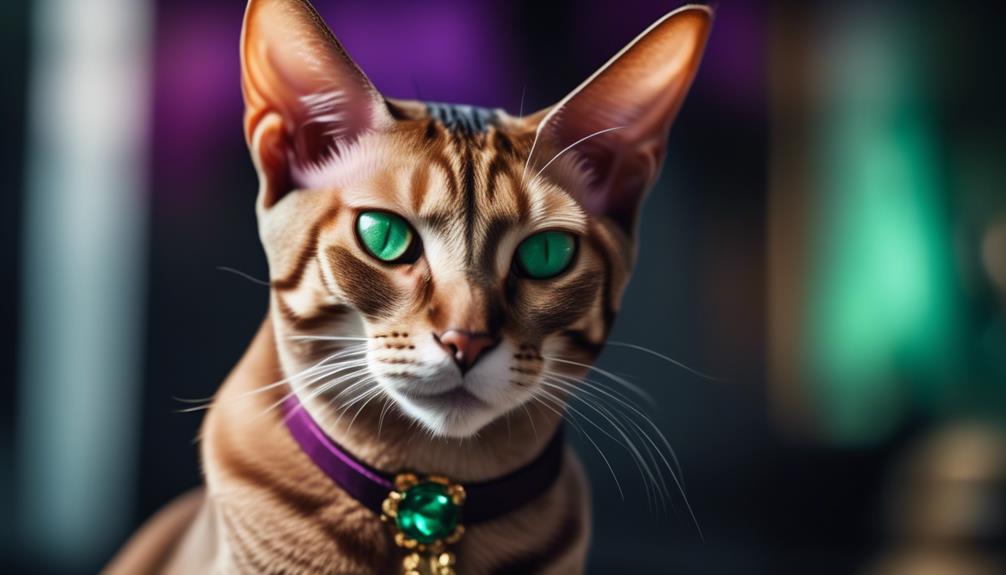
Welcome to the world of Oriental cats, where elegance meets intelligence and conversation flows freely.
As we explore Oriental cat breed information and characteristics, prepare to be captivated by their unique charm and distinctive traits.
From their origins in the United Kingdom to their stunning appearance and social nature, there is much to discover about these enigmatic felines.
Stay tuned as we delve into their fascinating history, explore their diverse coat patterns, and unveil their care and grooming secrets.
Brace yourself for a journey that will leave you wanting to know more about these captivating creatures.
Key Takeaways
- The Oriental cat breed originated in the United Kingdom in the 1950s due to the crossing of Siamese cats with other shorthaired breeds.
- Orientals are medium-sized cats weighing 7-12 pounds and having a 15-20 year lifespan.
- They have short, sleek, and glossy coats in ovcome0 patterns and colors, resembling Siamese cats but with more variety.
- Orientals are known for their talkative and opinionated nature, affection towards their owners, social behavior, and need for attention. They are also playful, intelligent, and agile.
Origin and Development
The Oriental cat breed originated in the United Kingdom in the 1950s through the deliberate crossing of Siamese cats with other shorthaired breeds.
This intentional breeding program aimed to create a cat with the elegant body of the Siamese but with a broader range of coat colors and patterns.
The result was a breed that retained the sleek body type and almond-shaped eyes of the Siamese but with a much wider variety of coat colors and patterns.
The Oriental cat breed quickly gained popularity due to its striking appearance and lively personality.
Today, Orientals are recognized by significant cat associations as a distinct breed.
They are known for their talkative nature, affectionate temperament, and high intelligence.
See another cat breed profile.
Oriental Bicolor Mixed Cat Breed
Size and Breed Group
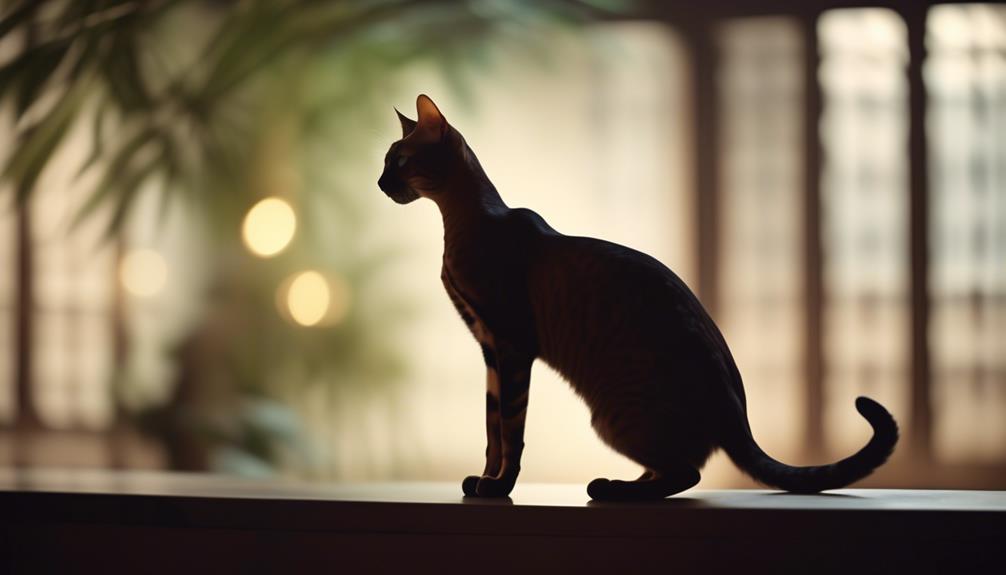
With a medium size ranging from 7 to 12 pounds, the Oriental cat belongs to the breed group of Oriental Shorthairs, which significant cat associations recognize.
These cats have a slender, muscular body with long lines and a wedge-shaped head.
Their ears are unusually large, broad at the base, and pointed at the tip.
Orientals also have almond-shaped, medium-sized eyes that can be blue, green, or odd (one blue and one green). The Oriental Shorthair has a short, sleek, and glossy coat with many colors and patterns.
Additionally, there is a longhaired variety of Oriental cats that also exist.
Lifespan and Health
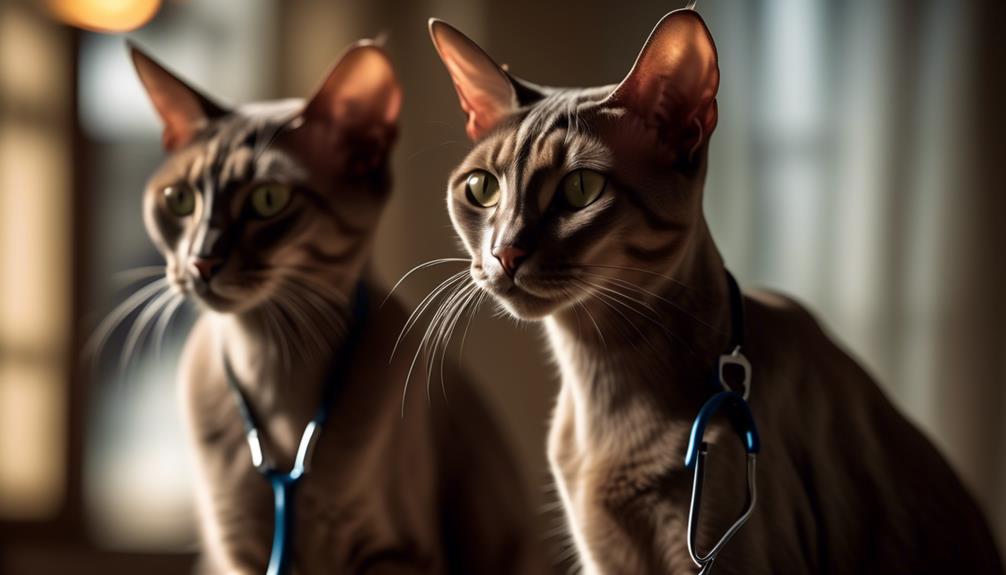
Continuing our exploration of the Oriental cat breed, let us focus on their lifespan and health.
Oriental cats are known for their longevity, with an average lifespan of 15 to 20 years.
However, it is essential to note that individual cats may vary, and genetics, diet, exercise, and overall care can influence their lifespan.
Regarding health, Oriental cats are generally considered a healthy breed with no specific breed-related health issues.
However, they may be prone to certain common health conditions among all cats, such as dental problems, obesity, and urinary tract issues.
Regular veterinary check-ups, a balanced diet, and an active lifestyle can help ensure the overall health and well-being of Oriental cats.
Coat Characteristics
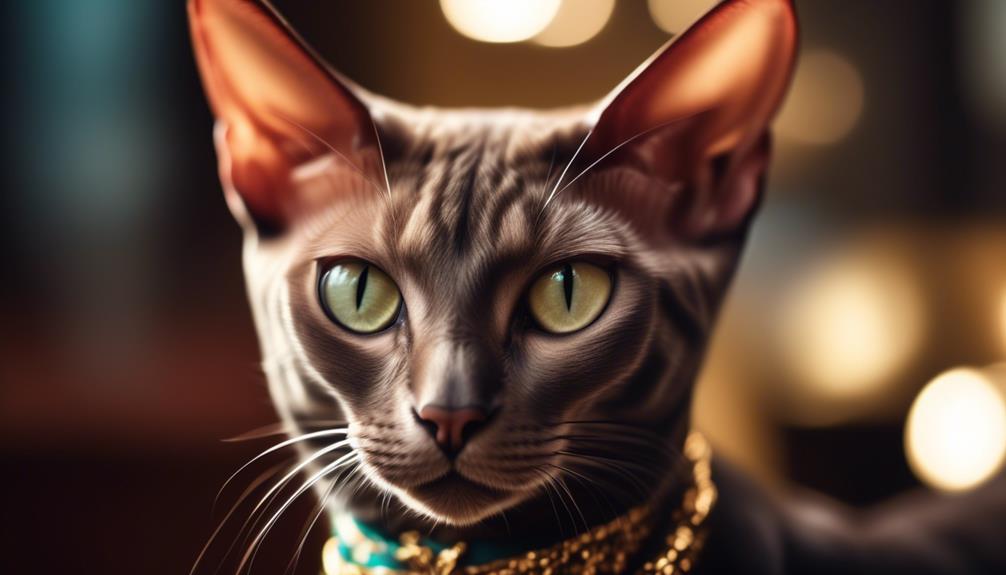
Oriental cats are known for their striking and diverse coat characteristics. Their coats are one of the main features that make them stand out from other breeds.
Here are some notable coat characteristics of Oriental cats:
- Vast Array of Colors: Orientals come in various colors, including solid, tabby, tortoiseshell, and color point.
- Rich and Glossy: Their coats are short, sleek, and glossy, giving them a luxurious appearance.
- Unique Patterns: Orientals can have various patterns, such as classic tabby, spotted, mackerel, and ticked.
- Color Intensity: The colors on their coats are often intense and vibrant, adding to their overall allure.
- Eye-catching Contrast: The contrast between their coat color and their striking almond-shaped eyes is often breathtaking.
These coat characteristics contribute to the Oriental cat’s distinctive and captivating appearance.
Whether it’s their rich colors, unique patterns, or glossy coats, Oriental cats are a sight to behold.
Coat Patterns and Varieties
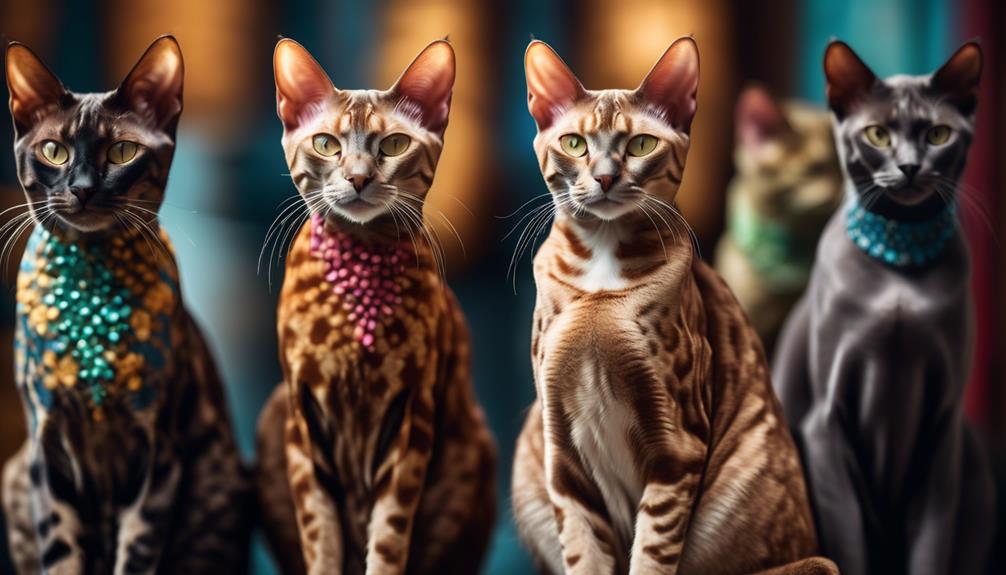
A wide range of coat patterns and varieties can be found in Oriental cats. These cats come in various colors and patterns, visually striking and unique.
Some common coat patterns include solid, tabby, tortoiseshell, and colorpoint.
Solid Orientals have a single, uniform color throughout their coat, while tabby Orientals have distinctive stripes or swirls.
Tortoiseshell Orientals display a combination of black, orange, and cream colors in a mottled pattern.
Colorpoint Orientals have a lighter body color with darker points on their ears, faces, paws, and tails.
Additionally, Oriental cats can combine these patterns, creating even more variety.
The coat patterns and varieties of Oriental cats contribute to their overall beauty and charm.
Personality Traits
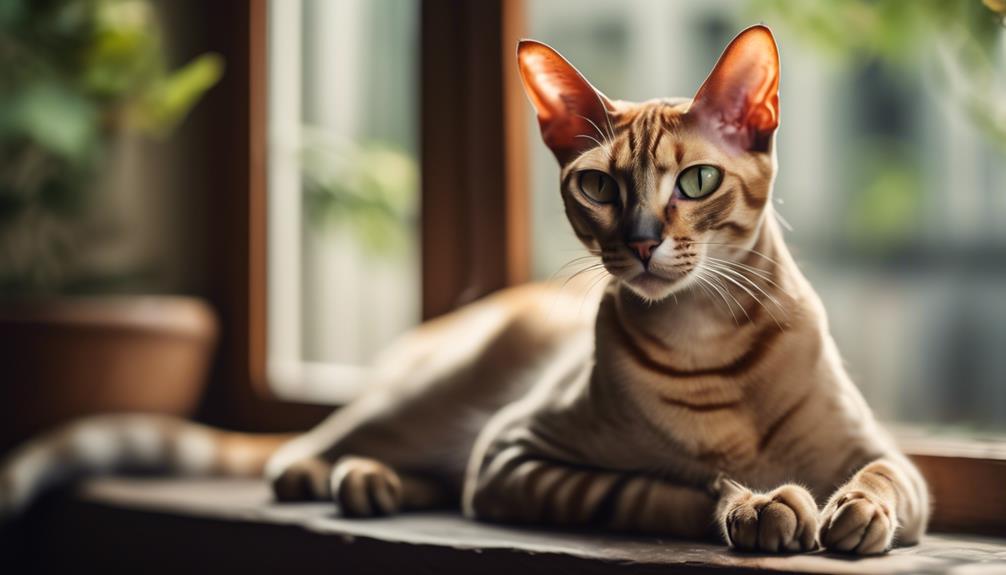
With their talkative nature and strong opinions, Oriental cats are known for their expressive personality.
Here are five key traits that make them unique:
- Talkative: Orientals love to communicate and are not shy about expressing their thoughts through vocalizations.
- Affectionate: These cats are incredibly fond of their people and enjoy being close to them, often seeking out physical contact and cuddles.
- Social: Orientals like to be involved in their owners’ activities and often follow them around the house, wanting to be part of the action.
- Playful: Highly intelligent and agile, Orientals have a playful nature and enjoy interactive toys and games that challenge their mental and physical abilities.
- Need for Attention: Orientals thrive on attention and don’t like to be left alone for long periods. They may benefit from having a companion cat to keep them company.
Talkative and Opinionated
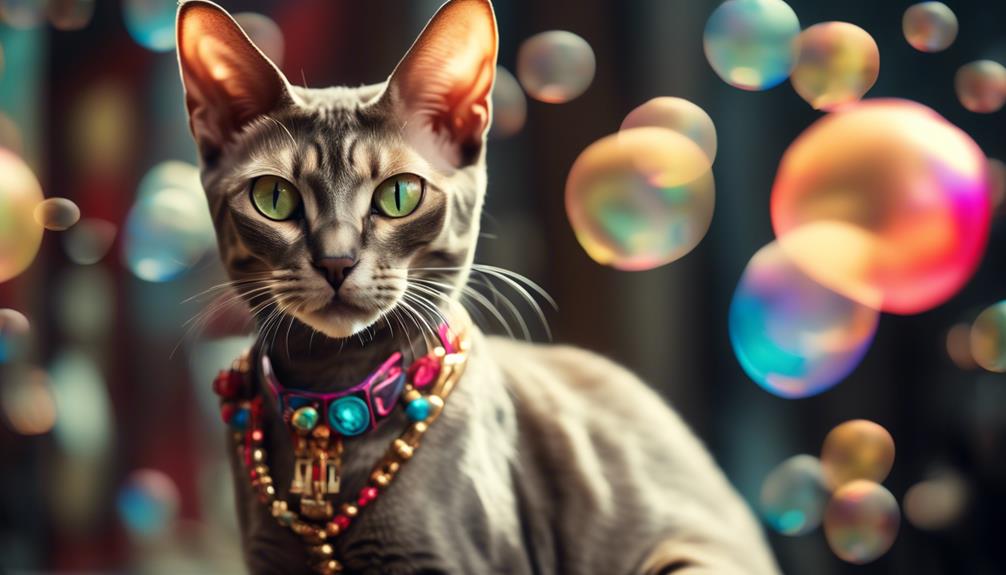
Known for their expressive personality, Oriental cats are highly talkative and opinionated.
They have a reputation for being quite vocal and will often engage in conversations with their owners.
These cats have vocalizations, from soft chirps and trills to loud yowls and meows.
They are unafraid to express their opinions and will tell you exactly what they want or need.
To give you a better understanding of their communication style, here is a table showcasing some common vocalizations and their meanings:
| Vocalization | Meaning |
|---|---|
| Chirp | Excitement or greeting |
| Trill | Happiness or contentment |
| Meow | Request for attention or food |
| Yowl | Displeasure or pain |
Oriental cats’ talkative nature adds to their charm and makes them engaging companions for those who enjoy lively conversations with their feline friends.
Affectionate and Social
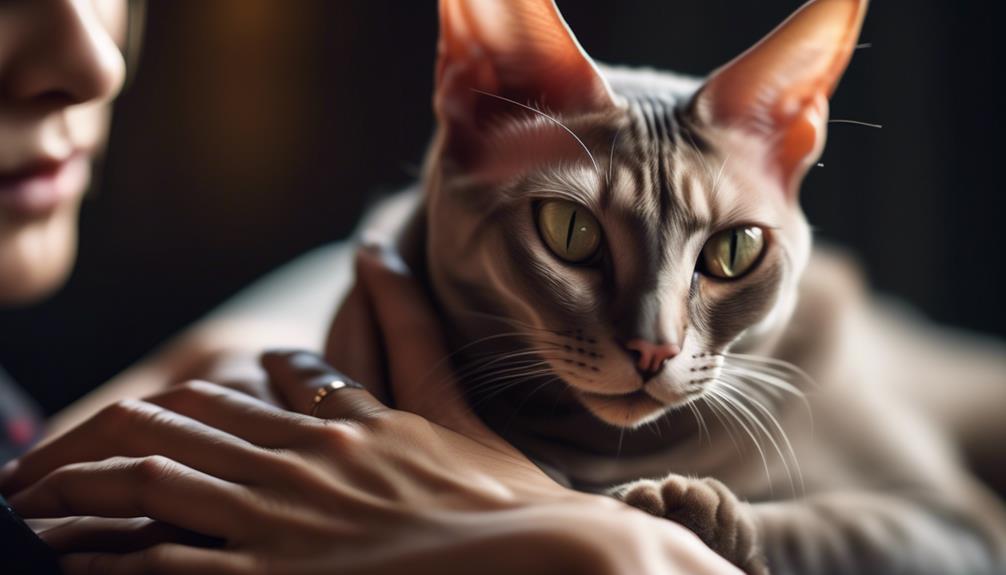
Oriental cats are beloved for their affectionate and friendly nature, making them delightful companions for those seeking a loving and interactive feline friend.
These cats thrive on human interaction and enjoy being involved in their owners’ activities.
Here are five key characteristics that make Oriental cats so affectionate and social:
- Bonding: Orientals form strong bonds with their human companions and enjoy being close to them.
- Lap cats love to curl up on their owner’s lap, soaking up warmth and affection.
- Playfulness: Orientals are highly active and enjoy interactive play sessions with their owners.
- Vocalization: They express affection through soft purrs and gentle meows, communicating their love and contentment.
- Sociability: They are known for their friendly and welcoming nature, making them great companions for visitors and pets.
Playful and Intelligent
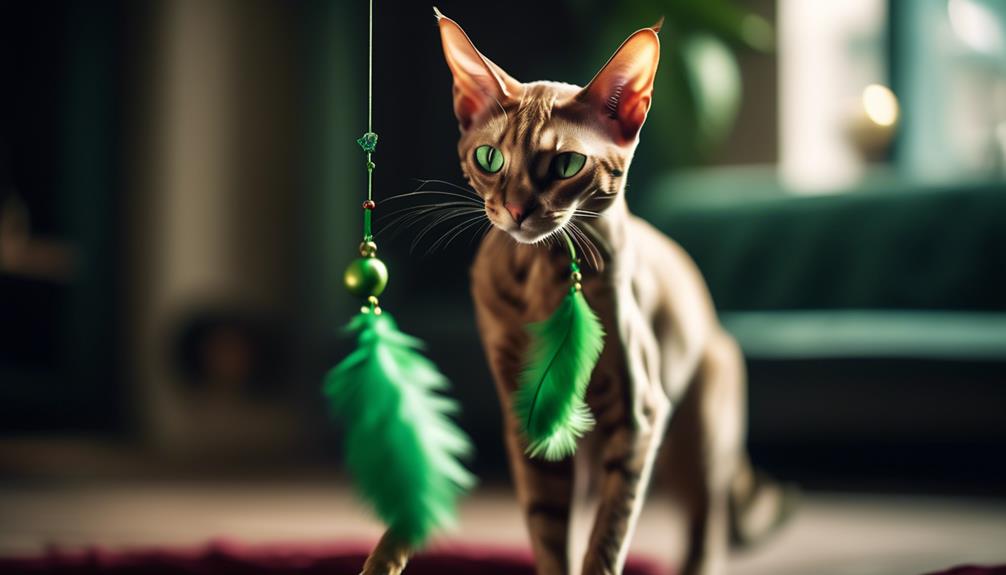
Orientals are known for their playful nature and high level of intelligence.
These cats are highly active and enjoy engaging in various play activities.
They are agile and athletic, making them excellent climbers and jumpers.
Orientals are curious, constantly exploring their environment and seeking mental stimulation.
Their intelligence allows them to quickly learn new tricks and games, making them an ideal choice for owners who enjoy interactive play.
Their intelligence also makes them highly adaptable, allowing them to quickly adjust to new situations and environments.
With their playful and intelligent nature, Orientals make lovely companions for individuals and families looking for an active and mentally stimulating pet.
Need for Attention and Companionship
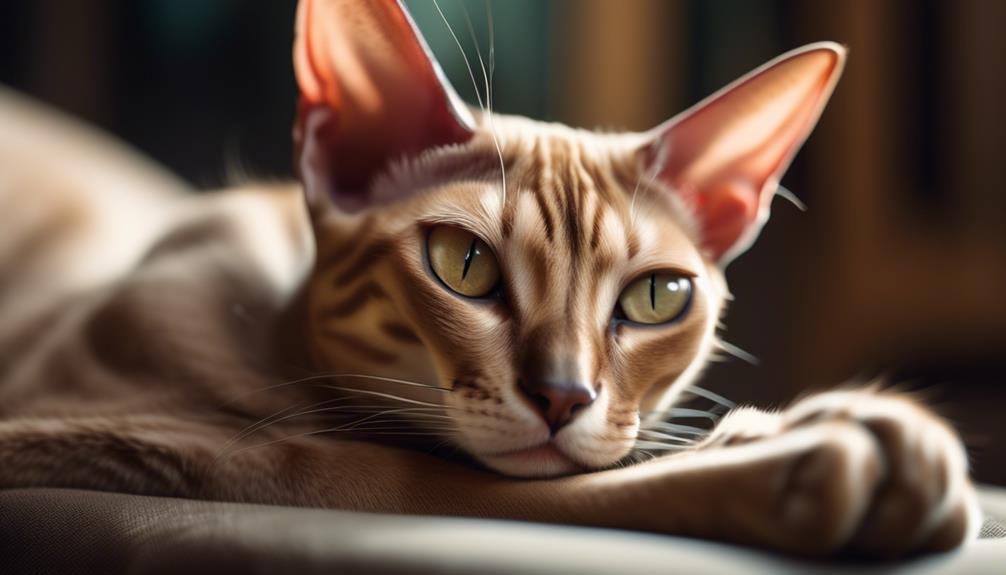
With their lively and friendly nature, Oriental cats strongly need attention and companionship.
They thrive on human interaction and form close bonds with their owners.
Here are five reasons why Oriental cats crave attention and companionship:
- Affectionate nature: Orientals are incredibly fond of their people and enjoy being close to them. They will seek out cuddles and loving gestures.
- Social behavior: These cats like to follow their owners around and be involved in their activities. They enjoy being part of the household and will actively engage with family members.
- Talkative tendencies: Orientals are known for being talkative and expressing their opinions. They will meow and vocalize to get attention and communicate with their humans.
- Playful personality: These cats are brilliant, agile, and athletic. They love interactive play sessions and will eagerly participate in games with their owners.
- Need for companionship: Orientals don’t like being alone for long periods and may benefit from having a companion cat. They appreciate having a feline friend to keep them company when their owners are away.
Meeting the need for attention and companionship is essential to ensure the happiness and well-being of Oriental cats.
Care and Grooming Tips
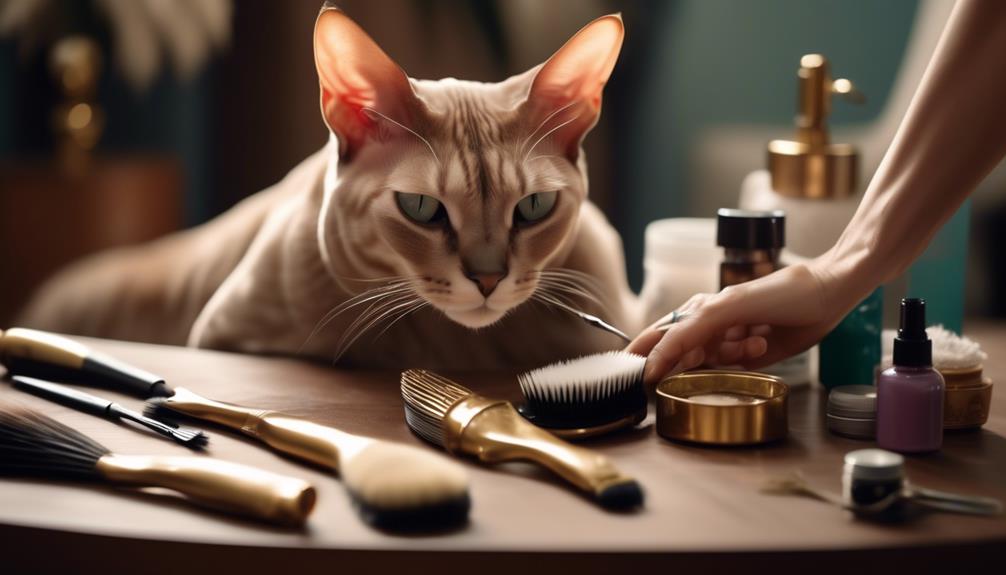
To properly care for an Oriental cat, it is essential to understand their specific grooming needs.
The Oriental Shorthair has a short, fine coat that is easily cared for. Regularly combing the coat with a stainless steel comb or soft bristle brush will help remove dead hair.
It can be polished with a soft cloth to make the coat shine.
Brushing the teeth is essential to prevent periodontal disease.
The corners of the eyes should be wiped with a soft, damp cloth to remove any discharge.
Checking the ears weekly and cleaning them with a cotton ball or soft, damp cloth moistened with cider vinegar and warm water is recommended.
Keeping the litter box clean is essential to maintain good bathroom hygiene.
Consider keeping the Oriental as an indoor-only cat to protect it from diseases and dangers outdoors. Outdoor Orientals may be at risk of being stolen.
Coat Care and Maintenance
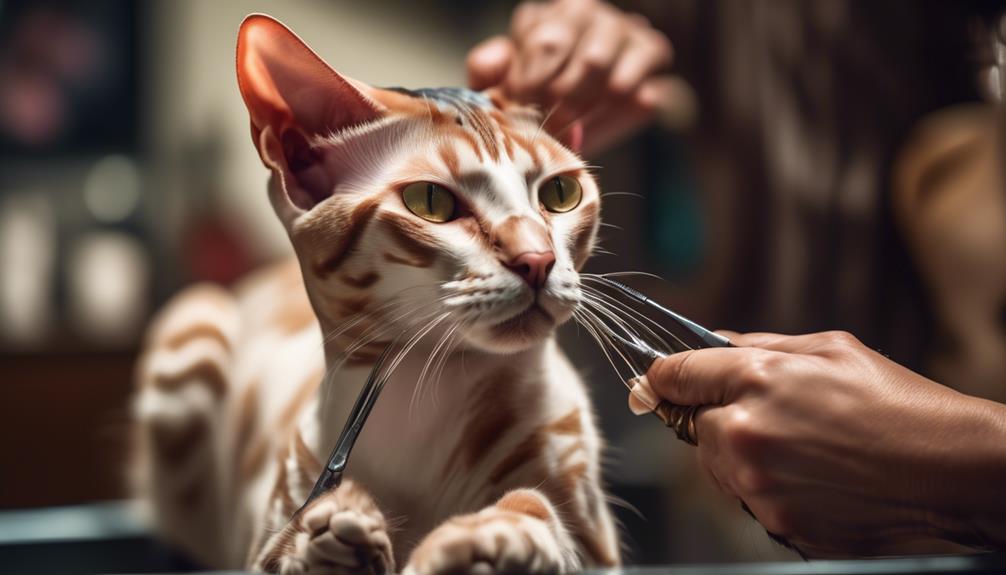
Proper coat care and maintenance are crucial to ensure the well-being and appearance of the Oriental cat breed.
To keep their coat in optimal condition, here are five essential tips for coat care and maintenance:
- Regular grooming: Brush your Oriental cat’s coat with a stainless steel comb or soft bristle brush to remove dead hair and prevent matting.
- Polishing the coat: Use a soft cloth to buff it and make it shine.
- Dental hygiene: Brush your cat’s teeth regularly to prevent periodontal disease.
- Eye care: Wipe the corners of the eyes with a soft, damp cloth to remove discharge and maintain eye health.
- Ear cleaning: Check the ears weekly with a cotton ball or soft, damp cloth moistened with cider vinegar and warm water.
These coat care and maintenance practices will help your Oriental cat maintain a healthy and lustrous coat.
Dental and Eye Care
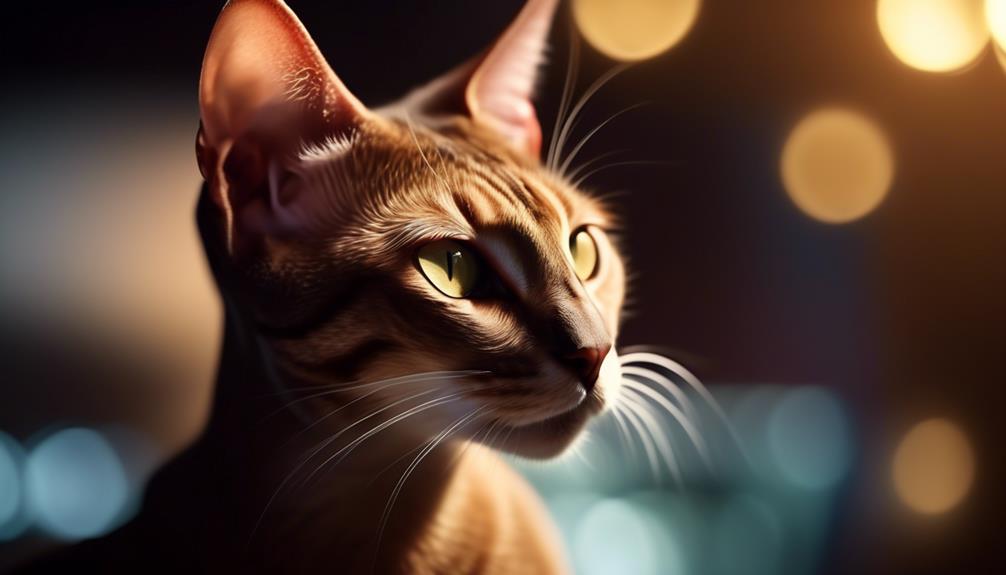
Maintaining proper dental and eye care is essential for the overall health and well-being of Oriental cats.
Regular dental care helps prevent periodontal disease, which can lead to pain, tooth loss, and other health issues.
Brushing the teeth regularly and providing dental treats or toys can help keep the teeth clean and healthy.
In terms of eye care, wiping the corners of the eyes with a soft, damp cloth helps remove any discharge and prevent the buildup of debris.
Regular check-ups with a veterinarian are also essential to monitor the overall health of their eyes.
| Dental Care Tips | Eye Care Tips |
|---|---|
| Brush teeth regularly | Wipe the corners of your eyes with a soft, damp cloth |
| Provide dental treats or toys | Regular check-ups with a veterinarian |
| Watch for signs of dental issues, such as bad breath or difficulty eating | Monitor overall eye health and address any concerns |
Ear Care and Hygiene
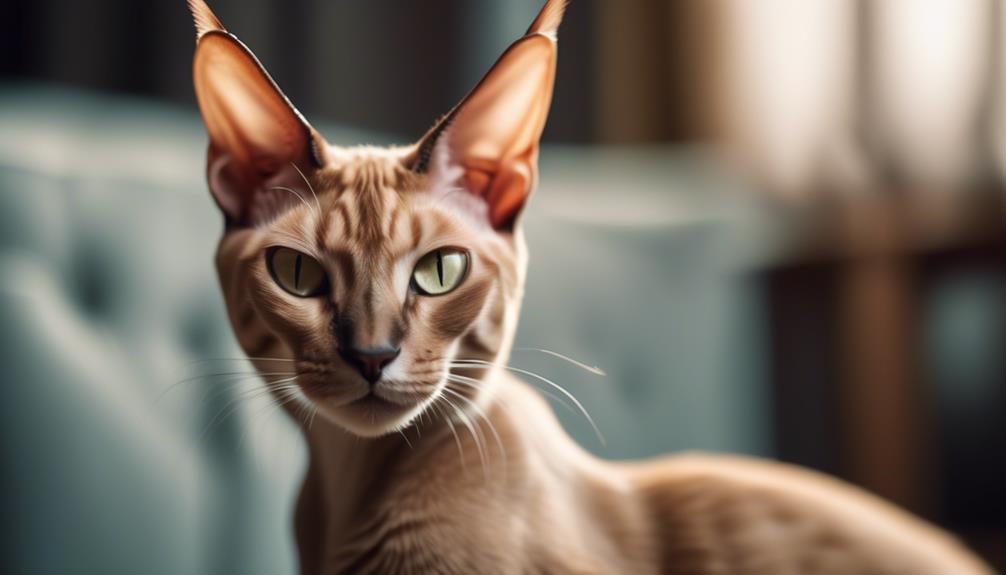
Ear care and hygiene are crucial aspects of maintaining the health and well-being of Oriental cats.
Proper ear care helps prevent infections and keeps the ears clean and comfortable.
Here are five essential tips for keeping your Oriental cat’s ears in good condition:
- Regularly inspect your cat’s ears for signs of redness, swelling, discharge, or odor.
- Clean your cat’s ears gently using a veterinarian-approved ear-cleaning solution and cotton balls or pads.
- Avoid using cotton swabs or sharp objects that can damage the delicate ear canal.
- Trim excess hair around the ears to prevent it from blocking airflow and trapping dirt and debris.
- Schedule regular check-ups with your veterinarian to ensure your cat’s ears are healthy and promptly address any potential ear issues.
Frequently Asked Questions
Are Oriental Cats Hypoallergenic?
Oriental cats are not hypoallergenic.
While they have short, fine coats that are easily cared for, they still produce allergenic proteins in their saliva and dander, which can trigger allergies in sensitive individuals.
How Much Exercise Do Oriental Cats Need?
Oriental cats are highly active and require regular exercise to stay physically and mentally stimulated.
They enjoy interactive play sessions, puzzle toys, and climbing structures.
Aim for at least 30 minutes of daily exercise to keep them happy and healthy.
Can Oriental Cats Be Trained to Use a Litter Box?
Yes, Oriental cats can be trained to use a litter box.
With proper guidance and consistency, they can quickly learn to associate the litter box with eliminating waste, making them highly trainable.
Do Oriental Cats Require a Specific Diet?
Oriental cats do not require a specific diet, but like all cats, they need a balanced and nutritious diet to maintain their health.
Consult with a veterinarian to determine the best diet for your Oriental cat.
Are Oriental Cats Prone to Any Specific Health Issues?
Oriental cats are generally healthy but can be prone to specific health issues.
These may include dental problems, respiratory issues, and genetic conditions such as amyloidosis and progressive retinal atrophy.
Regular vet check-ups and proper care can help prevent and manage these issues.
Conclusion
In conclusion, the Oriental cat breed is a captivating and beautiful breed that originated in the United Kingdom in the 1950s.
Known for their stunning appearance and wide array of coat patterns, Orientals are also highly intelligent, affectionate, and social.
With a lifespan of 15-20 years, they require regular grooming and care to maintain their short and sleek coat.
Overall, the Oriental cat breed is a beautiful choice for those seeking a talkative and playful companion.




